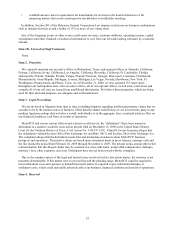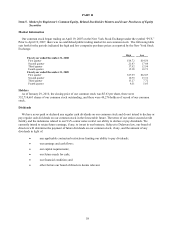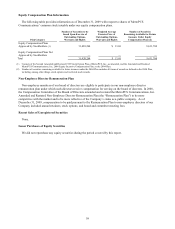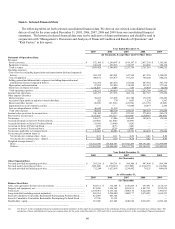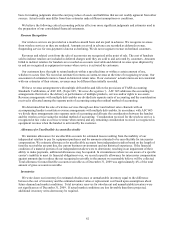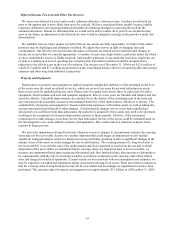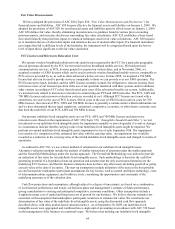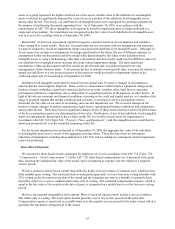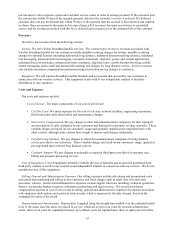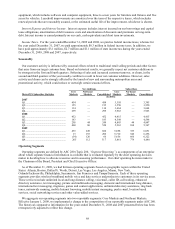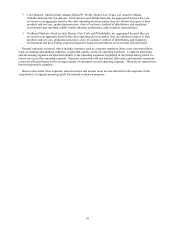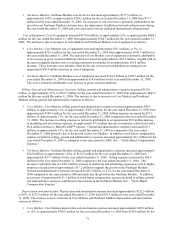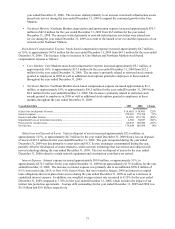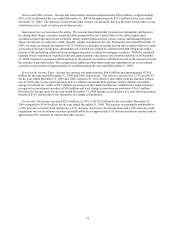Metro PCS 2009 Annual Report Download - page 76
Download and view the complete annual report
Please find page 76 of the 2009 Metro PCS annual report below. You can navigate through the pages in the report by either clicking on the pages listed below, or by using the keyword search tool below to find specific information within the annual report.64
Fair Value Measurements
We have adopted the provisions of ASC 820 (Topic 820, “Fair Value Measurements and Disclosures”) for
financial assets and liabilities. ASC 820 became effective for financial assets and liabilities on January 1, 2008. We
adopted the provisions of ASC 820 for non-financial assets and liabilities upon its effectiveness on January 1, 2009.
ASC 820 defines fair value, thereby eliminating inconsistencies in guidance found in various prior accounting
pronouncements, and increases disclosures surrounding fair value calculations. ASC 820 establishes a three-tiered
fair value hierarchy that prioritizes inputs to valuation techniques used in fair value calculations. ASC 820 requires
us to maximize the use of observable inputs and minimize the use of unobservable inputs. If a financial instrument
uses inputs that fall in different levels of the hierarchy, the instrument will be categorized based upon the lowest
level of input that is significant to the fair value calculation.
FCC Licenses and Microwave Relocation Costs
We operate wireless broadband mobile networks under licenses granted by the FCC for a particular geographic
area on spectrum allocated by the FCC for terrestrial wireless broadband mobile services. We hold personal
communications services, or PCS, licenses granted or acquired on various dates, and in November 2006, we
acquired a number of AWS licenses which can be used to provide wireless broadband mobile services comparable to
PCS services provided by us, as well as other advanced wireless services. In June 2008, we acquired a 700 MHz
license that also can be used to provide services comparable to those we can provide over our AWS spectrum. The
PCS licenses previously included, and the AWS licenses currently include, the obligation to relocate existing fixed
microwave users of our licensed spectrum if the use of our spectrum interfered with their systems and/or reimburse
other carriers (according to FCC rules) that relocated prior users if the relocation benefits our system. Additionally,
we incurred costs related to microwave relocation in constructing our PCS and AWS networks. The PCS, AWS and
700 MHz licenses and microwave relocation costs are recorded at cost. Although FCC licenses are issued with a
stated term, ten years in the case of PCS licenses, fifteen years in the case of AWS licenses and ten years for 700
MHz licenses, the renewal of PCS, AWS and 700 MHz licenses is generally a routine matter without substantial cost
and we have determined that no legal, regulatory, contractual, competitive, economic, or other factors currently exist
that limit the useful life of our PCS, AWS and 700 MHz licenses.
Our primary indefinite-lived intangible assets are our PCS, AWS and 700 MHz licenses and microwave
relocation costs. Based on the requirements of ASC 350 (Topic 350, “Intangibles-Goodwill and Other”), we test
investments in our indefinite-lived intangible assets for impairment annually or more frequently if events or changes
in circumstances indicate that the carrying value of our indefinite-lived intangible assets might be impaired. We
perform our annual indefinite-lived intangible assets impairment test as of each September 30th. The impairment
test consists of a comparison of the estimated fair value with the carrying value. An impairment loss would be
recorded as a reduction in the carrying value of the related indefinite-lived intangible assets and charged to results of
operations.
As outlined in ASC 350, we use a direct method of valuation for our indefinite-lived intangible assets.
Alternative valuation methods include the analysis of similar transactions of spectrum under the market approach
and the Greenfield Methodology under the income approach. The Greenfield Methodology was utilized to provide
an indication of fair value for our indefinite-lived intangible assets. Such methodology is based on the cash flow
generating potential of a hypothetical start-up operation and assumes that the only assets upon formation are the
underlying FCC licenses, and that the business enterprise does not have any other assets including goodwill or going
concern value at the date of inception. The start-up assumptions include utilization of the asset in the best possible
use and incorporate marketplace participant assumptions for key factors, such as current and future technology, costs
of telecommunications equipment, and workforce costs, considering the opportunities and constraints of the
underlying spectrum as of the valuation date.
Cash flow projections and assumptions, although subject to a degree of uncertainty, are based on a combination
of our historical performance and trends, our business plans and management’s estimate of future performance,
giving consideration to existing and anticipated competitive economic conditions. Other assumptions include a
weighted average cost of capital and long-term rate of growth for our business. We believe that our estimates are
consistent with assumptions that marketplace participants would use to estimate fair value. We corroborate our
determination of fair value of the indefinite-lived intangible assets, using the discounted cash flow approach
described above, with other market-based valuation metrics. As of September 30, 2009, our indefinite-lived
intangible assets were aggregated and combined into a single unit of accounting in accordance with ASC 350 based
on the management of the business on a national scope. We believe that utilizing our indefinite-lived intangible





